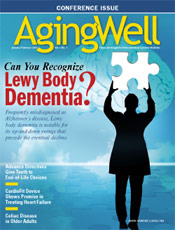
January/February 2013
Aging and Exercise: What Does the Research Say?By Michael J. Joyner, MD Over the last few months, I have reviewed several research issues related to aging in general and specifically the relationship between exercise and healthy aging. So what have I learned that I think physicians should know? First, in 1950, about 56% of men and 65% of women in the United States reached the age of 65, according to the Social Security Administration. Once people reached 65, on average men lived about 13 more years and women lived about 16 more years. According to World Bank statistics, in 2010, 84% of men and 89% of women reached the age of 65. Men who turned 65 in 2010 are projected to live 17 more years and women 19 more years. These numbers are likely to continue to increase, so aging is here to stay. The year 2000 marked the first time in history that there were more people on Earth over the age of 60 than under the age of 5, according to a United Nations report. For people who don’t smoke, don’t drink too much, watch their weight, remain active, and stay socially engaged, life expectancy can increase beyond what’s mentioned above. Those life expectancy numbers can shift upward by about 5 to 10 years. In study after study, these habits prove to be decisive and are strong predictors of living independently as we age. For example, as part of the Honolulu Heart Program, more than 9,000 Japanese American men have been followed for decades, and the participants who thrive into their 80s and 90s didn’t smoke, had a lifelong history of being active, and their mothers also reached the age of 80. While people can’t control how long their mothers will live, they can choose to avoid smoking and to remain active, especially by regularly exercising. But how much exercise is enough? Organizations such as the Centers for Disease Control and Prevention suggest 30 to 60 minutes of moderate to vigorous walking on most days but benefits start with even less activity. The risk of all sorts of disease, but especially diabetes and cardiovascular disease, is reduced by about one-half in people who follow exercise guidelines, and active people can live about five years longer on average than inactive people. So there’s no need to sign up for a marathon to reap the benefits of exercise. Will exercise help even people who are overweight or obese? The short answer is yes. In the last 20 or so years, research has shown that being active is especially important if patients are overweight or obese and can limit the risk of diseases such as diabetes and hypertension that are seen more frequently in this population. More importantly, high levels of physical activity seem to blunt the negative effects of many risk factors. In other words, conditions such as high cholesterol, high blood pressure, and diabetes are harmful but not as significantly so in the most physically active people. It’s important to exercise not only the body but also the brain. Probably the most exciting findings about exercise and aging in the last five to 10 years center on what exercising the body does to the brain. Exercise helps keep brain cells healthy, keeps the blood vessels delivering plenty of oxygen to the brain, enhances the connections between brain cells, and may even help grow new brain cells. We all fear developing Alzheimer’s disease as we get older, but it turns out that about 50% of the risk of Alzheimer’s is linked to the five key behaviors previously mentioned plus hypertension and diabetes. The data on exercise and aging have never been clearer—but the data miss one key point. Almost all of us remember a mischievous, “crazy” older friend or relative who was fit and engaged enough in life to instigate with the kids and teenagers at family or community gatherings. That having been said, who wants to miss the opportunity to be everyone’s favorite “crazy aunt/crazy uncle” as they get older? The teenagers need all the help they can get. — Michael J. Joyner, MD, is a physician and medical researcher at the Mayo Clinic in Rochester, Minnesota, with interest in exercise physiology and aging. He also blogs on his website at www.drmichaeljoyner.com. |
![]()
